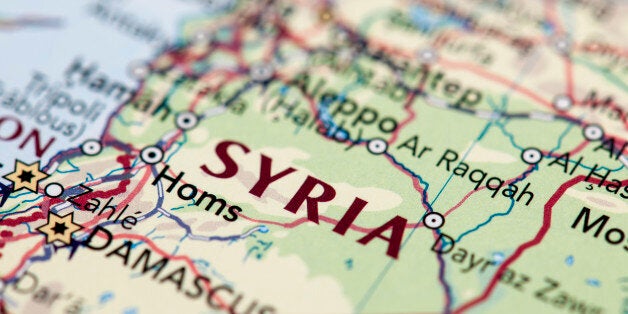
What is there left to say about Syria? The horrors have been reported on and reported on. Discussed and discussed. Outside of the human rights, diplomatic and aid communities, you suspect the wider public is finding it hard to focus on any more.
To be sure, things are still catastrophically bad for millions of people in Syria (as well as millions more forced into exile outside the country). And these harsh realities are still - fitfully - reflected in ongoing news reports about humanitarian aid, on sarin gas attacks, on fighting and its effect on beleaguered civilians, on the difficulties and perils of life as a Syrian refugee, and much else.
But at the same time Syria has somehow faded into a semi-permanent backdrop to other world events. Which is why the deeper immersion provided by a documentary like Sara Afshar's film Syria's Disappeared: The Case Against Assad is so important.
Here we're forced to take a steady look at some of the individual horror stories from Syria. Mariam Hallak, the mother of a young dentistry graduate called Ayham Ghazoul, talks about her prolonged and increasingly desperate efforts to uncover what happened to him after he was arrested by government security forces. Only much later does she discover that he'd been killed in detention only days after his arrest.
We hear from a man called Mansour al-Omari who survived the horrors of torture in a government detention facility. In an unforgettable passage in the documentary, al-Omari describes how he and his fellow detainees, fearing they would all die in jail with their relatives never learning of their fate, hatched a plan to smuggle out a list of the detainees' names if any of them should be released. They tore strips of cloth from their own ragged shirts and scratched out their names using a fragment of chicken bone found on a cell floor. The ink was their own blood mixed with rust. When Mansour is in fact the one released, he wore the shirt in which the cloth strips had been secretly sewn into the cuffs and collar.
And we hear from another torture survivor, the human rights activist Mazen Alhummada. Or, I should perhaps say, we see Mazen Alhummada. Because, in a searingly powerful sequence, we watch Alhummada's face after he's asked how he feels about the people who tortured him in jail. He processes the question for 40 painfully-extended seconds. Tears form in his eyes, gradually rolling down his cheeks. The camera doesn't move. You can hear him swallow. Then, almost calmly though he's clearly struggling with his emotions, Alhummada says: "God will hold them to account. The law will hold them to account. I will not rest until I take them to court and get justice."
Afshar's film tells us a lot about the mass arrests, the places where people were detained and tortured (including hospitals), and the ongoing investigations. International investigators have amassed huge dossiers of incriminating information comprising 600,000 pages of Syrian government documentation. Like the Nazis, those other bureaucratically-minded mass killers, some of Syria's human rights criminals could eventually be brought to justice because of their obsessive need to document their activities.
But Syria's Disappeared stays in the memory because of people like Mazen Alhummada, and in particular that moment of unbearable pain/calmness as he responds to the question about torture. To me it's reminiscent of the eerie stillness in some parts of The Horror In Homs, the award-winning Channel 4 film made by the French film-maker Mani in 2012. Asfar's documentary takes hold of you in a way that a 90-second TV news report on Syria is unlikely to. Allowing space for Mariam Hallak, Mansour al-Omari and Mazen Alhummada to speak at length (and even wait, think and eventually cry) is key to this.
One of the many tragedies of the Syria conflict is that after more than six years people not directly involved are finding it hard to be shocked or moved by it. In Even the appalling photographs of dead detainees we see in Syria's Disappeared (disfigured corpses photographed by the prison photographer "Caesar") have lost some of their power to shock. In her book Regarding The Pain Of Others, the writer Susan Sontag discusses the "adaptive" process whereby many people become accustomed to supposedly "shocking" images. "As one can become habituated to horror in real life, one can become habituated to the horror of certain images." Even photos of piles of dead bodies at Bergen-Belsen have lost some of their impact as they've become over-familiar. Sontag suggests there can be exceptions, that certain extremely horrific images can retain their potency, though I'm not really sure that's true. Repetition and familiarity eventually dull the senses.
My point about Sara Afshar's excellent Syria film is that what will stay with the viewer the longest is not the atrocity-porn-style photos of dead torture victims, dreadful though they are. It's the face of Mazen Alhummada. This mesmerisingly-watchable man, rather bird-like in his fluttering about in front of the camera, takes you into some small moment of unnameable horror as he thinks over the question of what should be done to rectify years of pain and suffering. It's this unbearable moment of stillness and Mazen's tears you'll remember.
*Syria's Disappeared: The Case Against Assad, which was originally shown on Channel 4 in March, is being screened at local Amnesty events around the country this autumn. There will also be a special screening event at Amnesty's London headquarters on 30 August.
